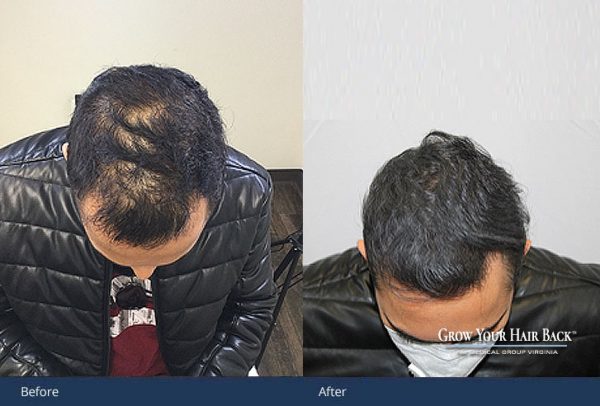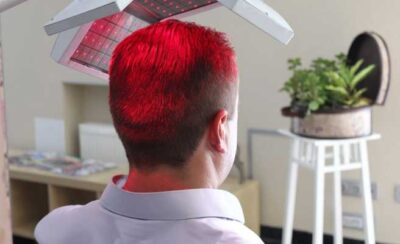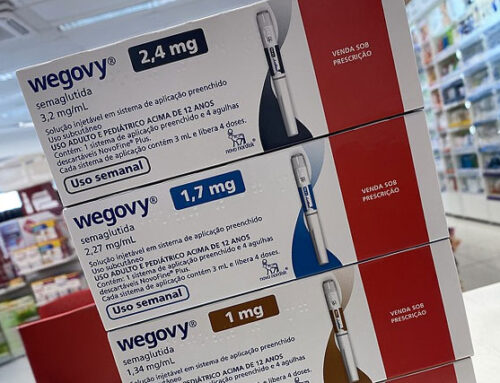Yes, But… The Nuanced Reality of Topical Hair Loss Treatments
Do topical hair loss treatments such as finasteride and minoxidil work for treating hair loss? Topical hair loss treatments do work for many people, but with significant caveats. Scientific research consistently shows that treatments like minoxidil and topical finasteride can effectively slow hair loss and stimulate regrowth in a significant percentage of users.
However, results vary widely between individuals, require consistent long-term use, and typically produce modest rather than dramatic improvements. For those wondering if these treatments are worth trying, the evidence suggests they are legitimate options with realistic expectations.

What Causes Hair Loss? And How Do You Stop It?
Before exploring treatments, it is important to understand what causes hair loss. The most common type of hair loss is androgenetic alopecia (AGA), also known as male or female pattern baldness. By age 50, approximately half of all men will exhibit some degree of AGA. This condition is primarily caused by:
- Genetic predisposition
- Hormonal factors, particularly dihydrotestosterone (DHT)
- Follicular miniaturization (hair follicles gradually becoming smaller)
While androgenetic alopecia does not pose direct physical health risks, it can significantly impact psychological well-being, self-esteem, and the resultant quality of life.
Topical Minoxidil: The Pioneer Treatment
Minoxidil was the first FDA-approved topical treatment for hair loss, originally developed as a blood pressure medication before researchers noticed its hair-growing side effects.
How Minoxidil Works
Minoxidil works through several mechanisms:
- Vasodilation: Increases blood flow to hair follicles
- Extends the anagen (growth) phase of hair
- Promotes thicker hair shafts
- May stimulate follicular progenitor cells
Effectiveness of Minoxidil
Research consistently shows that topical minoxidil is effective for many people:
- Available in 2% and 5% solutions (the latter showing better results)
- Studies show approximately 60% of users experience visible hair regrowth
- Results typically appear after 4-6 months of consistent use
- Requires continued application to maintain results
Minoxidil’s Limitations
- Works better for crown/vertex thinning than frontal hair loss
- Effectiveness varies widely among individuals
- Common side effects include scalp irritation, itching, and dryness
- Twice-daily application can be inconvenient and may impact adherence
Topical Finasteride: The Newer Alternative
Finasteride has traditionally been taken orally, but topical formulations have gained popularity in recent years as they may reduce systemic side effects. Finasteride works by:
- Inhibiting the type II 5α-reductase enzyme that converts testosterone to DHT
- Reducing DHT levels in the scalp, which helps prevent follicular miniaturization
- Addressing the hormonal component of hair loss directly
Effectiveness of Finasteride
Recent research on topical finasteride is promising. A 2022 Phase 3 clinical trial showed that topical finasteride (0.25% solution) was as effective as oral finasteride in promoting hair growth. Patients using topical finasteride maintained better DHT levels and experienced nearly 2% fewer sexual side effects compared to oral finasteride. Combined with minoxidil, topical finasteride shows potentially enhanced results.
Limitations of Finasteride
- Contraindicated for women who are pregnant or may become pregnant
- Relatively newer treatment with fewer long-term studies
- Not universally available in all markets
- Still may cause some systemic absorption and side effects
Low-Level Laser Therapy: Light-Based Treatment
 Low-Level Laser Therapy (LLLT) represents a non-drug approach to treating hair loss that has gained scientific backing in recent years. FDA approved for treatment of androgenetic alopecia in both men and women, Low-Level Laser Therapy utilizes red light or near-infrared light (typically at wavelengths of 630-670 nm) to:
Low-Level Laser Therapy (LLLT) represents a non-drug approach to treating hair loss that has gained scientific backing in recent years. FDA approved for treatment of androgenetic alopecia in both men and women, Low-Level Laser Therapy utilizes red light or near-infrared light (typically at wavelengths of 630-670 nm) to:
- Stimulate cellular activity in the hair follicle
- Increase blood flow to the scalp
- Reduce inflammation
- Potentially extend the anagen phase of hair growth
In 2007, the FDA cleared low-level laser therapy (LLLT) devices for the treatment of androgenetic alopecia, a common form of hereditary hair loss, initially in men and later in women. These devices use specific wavelengths of light to penetrate the scalp and stimulate hair follicles, promoting increased cellular activity and blood flow, which may encourage hair regrowth and slow hair loss. LLLT is a non-invasive, pain-free option with minimal side effects, making it a popular alternative or complementary treatment to medications and hair restoration surgery.
Effectiveness of Laser Hair Therapy
Over the past 30 years, significant scientific evidence for LLLT has been building. Multiple randomized controlled trials and clinical studies have demonstrated its efficacy. A 2014 multicenter study showed significant improvements in hair counts and thickness after 26 weeks. As with minoxidil and finasteride, Laser Hair Therapy works best for individuals experiencing the early stages of hair loss.
The Verdict: Do Topical Hair Loss Treatments Really Work?
Based on the scientific evidence, the answer is a qualified yes—topical hair loss treatments do work for many people, but with important caveats:
- Effectiveness varies: Results differ significantly between individuals based on genetics, age, extent of hair loss, and consistency of use.
- Expectations matter: These treatments typically slow or stop hair loss and promote modest regrowth rather than restoring a full head of hair.
- Consistency is key: Results require months of regular application and continued use to maintain benefits.
- Earlier treatment is better: All treatments work best when started early in the hair loss process.
- Combination approaches show promise: Using multiple treatments simultaneously often produces better results than monotherapy.
Talk to a Hair Loss Specialist
If you’re experiencing hair loss, topical treatments like minoxidil and finasteride, as well as LLLT, represent scientifically backed options that can help many people. However, they are not miracle cures, and individual results will vary.
Before starting any treatment, consult with a dermatologist or hair loss specialist who can properly diagnose your condition and recommend the most appropriate treatment plan for your specific situation. They can also monitor for potential side effects and adjust your regimen as needed.
Remember that treating hair loss is typically a long-term commitment, and patience is key. With the right approach and realistic expectations, many people can successfully manage their hair loss and improve their hair density and appearance.
This article is for informational purposes only and does not constitute medical advice. Always consult with a healthcare professional before starting any treatment for hair loss.




